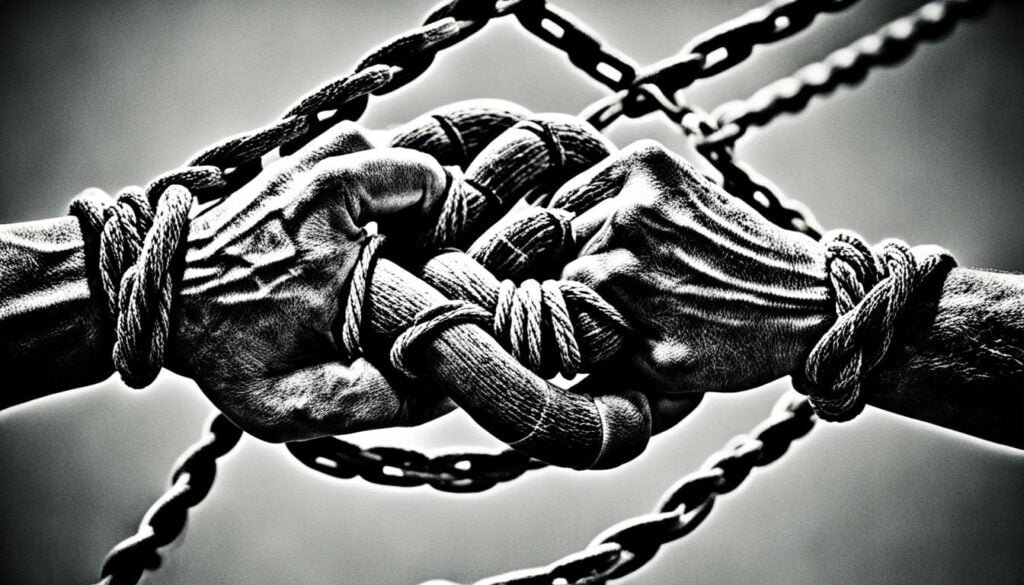Relationships are meant to add value to our lives, to bring joy, support, and a sense of belonging. But what happens when a relationship becomes more than just a source of happiness? What if it starts to consume our entire existence, leaving us feeling trapped, drained, and utterly dependent on the other person? Codependency? How to not be codependent?
Through self-reflection and a commitment to personal growth, I discovered the path to breaking free from the chains of codependency. It wasn’t easy, but the journey of recovery ultimately led me to a place of newfound self-awareness and empowered me to build healthier, more fulfilling relationships.
If you find yourself in a similar situation, feeling trapped in a codependent dynamic, know that you are not alone. There is hope for change, and by implementing specific strategies, you can regain your sense of self and cultivate relationships based on mutual respect and genuine connection.
In this article, we will dive into the world of codependency, explore its impact on relationships, and provide practical tips on how to break free from codependent patterns and start building healthy relationships. From setting boundaries to embracing self-care practices and seeking professional help, we will equip you with the tools to overcome codependency and create a life filled with healthier, more authentic connections.
Key Takeaways:
- Codependency in relationships can be suffocating and detrimental to our sense of self.
- Self-reflection and personal growth are essential for breaking free from codependent patterns.
- Setting boundaries, practicing self-care, and seeking help are crucial steps in overcoming codependency.
- By harnessing these strategies, you can learn how to not be codependent and cultivate healthier and more fulfilling relationships.
- Remember, change is possible, and you have the power to create the relationships you deserve.
Understanding Codependency in Relationships
In this section, we will delve into the various aspects of codependency in relationships. Understanding codependency is essential for recognizing and addressing unhealthy patterns that can hinder the development of healthy, fulfilling connections with others.
The Difference Between Love and Codependency
Love and codependency may seem similar on the surface, but there are important distinctions between the two. Love is characterized by mutual respect, support, and a healthy sense of self. Codependency, on the other hand, is an unhealthy reliance on others for validation, self-worth, and identity.
Codependent relationships tend to be one-sided, with individuals sacrificing their own needs and desires to meet the needs of their partner. This can lead to feelings of resentment, emotional exhaustion, and a loss of personal autonomy. Understanding the difference between love and codependency is crucial for building healthy relationships.
Recognizing Signs of Codependent Behavior
Recognizing the signs of codependent behavior is the first step towards breaking free from unhealthy relationship patterns. Some common signs of codependency include:
- Excessive people-pleasing, often at the expense of one’s own well-being
- Difficulty setting boundaries and saying no
- Anxiety or guilt when asserting one’s own needs
- A constant need for approval and validation from others
- A fear of abandonment and an excessive reliance on others for emotional stability
By understanding these signs, individuals can begin to recognize and address their codependent behaviors, paving the way for healthier relationships.
The Impact of Childhood Experiences on Adult Relationships
Childhood experiences play a significant role in shaping adult relationships, including codependent patterns. Children who grow up in homes where boundaries are blurred, communication is ineffective, or emotional needs are neglected are more likely to develop codependent tendencies in their adult relationships.
These early experiences can shape one’s understanding of love, intimacy, and self-worth. Without awareness and healing, these ingrained patterns can perpetuate codependent behaviors, undermining the potential for healthy, balanced connections.

How to Not Be Codependent
How to not be codependent? If you’re tired of feeling trapped by codependent patterns in your relationships, it’s time to take action and break free. Here are some practical tips and strategies to help you overcome codependency and foster healthier connections:
- Practice Self-Reflection: Take the time to reflect on your thoughts, emotions, and behaviors. Understand your own needs and desires outside of your relationships. This self-awareness is crucial for identifying and addressing codependent patterns in your interactions.
- Set Boundaries: Establish clear boundaries and communicate them effectively to others. This involves saying “no” when necessary and voicing your own needs and preferences. Remember, setting boundaries is not selfish—it is a necessary act of self-care to protect your emotional well-being.
- Foster Independence: Cultivate your own interests, hobbies, and goals outside of your relationships. Develop a sense of cultivating self-esteem and confidence independent of others’ opinions. Embrace your individuality and assert your independence to break free from codependency.
By incorporating these strategies into your daily life, you can empower yourself to overcome codependent patterns and build healthier relationships based on mutual respect and interdependence.
“The first step towards breaking free from codependency is realizing that you have the power to change your patterns and cultivate healthier connections.” – Anonymous
Setting Boundaries for Healthier Relationships
Setting boundaries is a crucial aspect of maintaining healthy relationships. It involves defining personal limits and communicating them effectively to others. By establishing clear boundaries, you can protect your well-being, maintain your individuality, and foster respect and understanding in your interactions with others.
Defining Personal Limits
Defining personal limits is an essential step in setting boundaries. It requires self-reflection and an understanding of your needs, values, and boundaries. Take the time to identify what is acceptable and unacceptable to you in various aspects of your relationships, such as emotional, physical, and social boundaries. By knowing your limits, you can communicate them effectively and ensure that your needs are met.
Defining personal limits can involve:
- Identifying what makes you feel uncomfortable or violated in a relationship.
- Recognizing your emotional and physical boundaries.
- Clarifying your expectations for privacy, personal space, and alone time.
When you have a clear understanding of your personal limits, you can effectively communicate them to others, setting the groundwork for healthier interactions.
Communicating Boundaries Effectively
Effective communication is key when expressing your boundaries to others. Here are some strategies to help you communicate your boundaries effectively:
- Be clear and direct: Clearly communicate your boundaries using assertive language. Avoid ambiguity and make sure your message is straightforward.
- Use “I” statements: Express your boundaries using “I” statements to take ownership of your feelings and needs. For example, say, “I need time alone to recharge” instead of “You always invade my personal space.”
- Be consistent: Consistently enforce your boundaries and follow through with consequences if they are violated. This will help others understand the importance of your boundaries.
- Practice active listening: Actively listen to others when they express their boundaries. Respect their limits, acknowledge their perspective, and find a middle ground that respects both parties.
By communicating your boundaries effectively, you can establish mutual understanding and respect within your relationships.
Dealing with Boundary Pushback
It is common to face boundary pushback from others when you begin setting and enforcing your boundaries. Here are some tips for handling boundary pushback:
- Stay firm: Stand your ground when others challenge your boundaries. Remain confident in your limits and assert the importance of respecting them.
- Provide explanations: Explain your reasons for setting certain boundaries to help others understand where you’re coming from. Use specific examples or share personal experiences that demonstrate the importance of your boundaries.
- Offer compromises: If appropriate, find compromises that meet the needs of all parties involved without compromising your own boundaries. This can help foster understanding and reinforce the importance of mutual respect.
- Seek support: Reach out to a trusted friend, family member, or therapist for support and guidance when facing boundary pushback. They can provide insight, validation, and advice.
Remember, setting boundaries is essential for cultivating healthier relationships. It allows you to prioritize your well-being and maintain healthy boundaries that foster respect, understanding, and personal growth.

Codependency and Addiction: Navigating Complex Dynamics
In this section, we will explore the intricate relationship between codependency and addiction. Codependent behaviors can often enable and perpetuate addictive patterns, creating a complex dynamic that can be challenging to overcome. By understanding the connection between codependency and addiction, individuals can take proactive steps towards breaking free from these destructive patterns and supporting their journey towards recovery.
Codependency, characterized by a strong reliance on others for self-worth and validation, can fuel addictive behaviors. The codependent individual may enable the addiction by constantly rescuing and enabling their addicted loved one, inadvertently becoming entangled in a web of dependence. This co-dependent relationship can maintain the addiction and hinder long-term recovery.
To overcome codependency in addiction, it is crucial to address the underlying issues and develop a strong support system. Open communication, professional counseling, and involvement in support groups can provide individuals with tools to navigate the complex dynamics of codependency and addiction. Learning to set healthy boundaries, balancing empathy with self-care, and fostering independence are essential steps towards overcoming codependency while supporting the recovery process.

The image above visually represents the intricate interplay between codependency and addiction. It serves as a reminder that breaking free from codependent patterns is a multifaceted journey, but one that is possible with the right tools and support.
Practical Steps to Healing from Codependency
When it comes to healing from codependency, taking practical steps is essential. By implementing specific strategies and practices, you can begin to break free from codependent patterns and foster healthier relationships. In this section, we will explore three key steps that can guide you on your journey towards healing and recovery.
Honesty and Transparency with Self and Partner
Honesty and transparency are vital components of healing from codependency. It is crucial to be honest with yourself about your own emotions, needs, and boundaries. Acknowledging and accepting your feelings without judgment allows for self-awareness and growth. Additionally, cultivating open and honest communication with your partner is essential in building trust and fostering a healthy relationship. Both you and your partner can work together to create an environment where honesty and transparency thrive.
Nurturing Self-Esteem and Positive Self-Image
One of the fundamental aspects of healing from codependency is nurturing your self-esteem and cultivating a positive self-image. Building self-esteem involves recognizing your worth, embracing your strengths, and acknowledging your accomplishments. Engaging in self-care practices, such as exercise, mindfulness, and self-reflection, can help boost your self-esteem and promote a positive self-image. Remember that you are deserving of love, respect, and happiness.
Learning to Make Independent Decisions
Codependency often involves a reliance on others to make decisions, leading to a loss of personal autonomy. To heal from codependency, it is important to learn how to make independent decisions. Start by identifying your own values, desires, and goals. Practice making small decisions on your own and gradually work towards more significant choices. Trust in your abilities and take ownership of your decisions, knowing that you have the power to create the life you desire.
By implementing these practical steps of honesty and transparency, nurturing self-esteem and positive self-image, and learning to make independent decisions, you can take significant strides towards healing from codependency. Remember that healing is a journey, and it is important to be patient and compassionate with yourself along the way.

| Practical Steps to Healing from Codependency |
|---|
| 1. Practice honesty and transparency with yourself and your partner |
| 2. Nurture self-esteem and cultivate a positive self-image |
| 3. Learn to make independent decisions |
Embracing Self-Care to Break the Cycle of Neediness
In order to overcome codependency and cultivate healthier relationships, it is crucial to prioritize self-care. Self-care involves nourishing your physical, mental, and emotional well-being, and it plays a vital role in breaking the cycle of neediness. By taking care of yourself, you can build a strong foundation of self-worth and independence, which are essential for balanced and fulfilling connections with others.
Understanding Self-Care
Self-care is a deliberate practice that involves engaging in activities and behaviors that promote self-nurturing and enhance overall well-being. It is about being attuned to your needs and actively taking steps to meet them. Self-care can include diverse activities such as exercise, eating nutritious food, getting enough rest, spending time in nature, pursuing hobbies, and seeking support from loved ones or professionals when needed.
Creating a Self-Care Routine
Developing a self-care routine is a powerful way to prioritize your well-being and break free from codependency. Here are some steps to help you create an effective self-care routine:
- Evaluate your needs: Take time to reflect on what areas of your life require attention and care. This could include physical, emotional, social, or spiritual aspects.
- Identify self-care activities: Make a list of activities that bring you joy, relaxation, and fulfillment. These can be activities that reduce stress, promote self-reflection, or enhance your sense of self.
- Set realistic goals: Determine how often you can engage in each self-care activity. Start with small, achievable goals to ensure consistency.
- Create a schedule: Establish a regular time for self-care and incorporate it into your daily or weekly routine. Treat it as a non-negotiable commitment to yourself.
- Flexibility and adaptability: Your self-care routine may need adjustments along the way. Be open to exploring new activities and adapting your routine to accommodate changes in your life.
Incorporating Mindfulness and Relaxation Techniques
Mindfulness and relaxation techniques can significantly enhance your self-care routine and support your journey towards breaking the cycle of neediness. These practices help you cultivate awareness, reduce stress, and foster inner peace. Consider incorporating the following techniques into your self-care routine:
- Meditation: Set aside a few minutes each day to practice mindfulness meditation. Focus on your breath, observe your thoughts without judgment, and cultivate a sense of presence.
- Deep breathing exercises: Take deep, slow breaths to activate your body’s relaxation response. Practice this technique whenever you feel overwhelmed or anxious.
- Journaling: Engage in reflective writing to explore your thoughts, emotions, and experiences. Writing can be a cathartic and insightful practice that promotes self-awareness.
- Yoga or stretching: Move your body and practice gentle stretching exercises to release tension and promote physical well-being.
Incorporating mindfulness and relaxation techniques into your self-care routine can help you reconnect with yourself, cultivate a sense of inner calm, and promote self-compassion.
By embracing self-care and prioritizing your well-being, you can break the cycle of neediness and foster healthier relationships. Remember, taking care of yourself is not selfish; it is an essential foundation for building fulfilling and balanced connections with others.
Seeking Help: Therapy and Support Groups for Recovery
In the journey towards codependency recovery, seeking professional help and joining support groups can be instrumental in finding guidance, understanding, and support. Therapy and support groups provide a safe and non-judgmental space for individuals to explore their codependent patterns, gain deeper insights, and learn healthier relationship dynamics.
Individual therapy offers personalized and focused attention from a licensed therapist who specializes in codependency. Through therapy sessions, you can delve into the root causes of codependency, develop self-awareness, and acquire coping mechanisms and tools for recovery. A skilled therapist will guide you in identifying and addressing underlying issues, helping you to build healthy boundaries, enhance self-esteem, and foster personal growth.
Couples therapy can be beneficial for individuals in codependent relationships. It allows both partners to gain a better understanding of their roles within the codependent dynamic and work towards building healthier patterns of interaction. In couples therapy, you and your partner can learn effective communication skills, develop strategies for setting mutual boundaries, and address underlying issues that contribute to codependency.
Support groups provide valuable peer support and a sense of community for individuals in recovery from codependency. Joining a codependency support group allows you to connect with others who share similar experiences and challenges. Sharing stories, insights, and coping strategies within the group can foster validation, empathy, and a sense of belonging. Support groups can be found both online and in-person, providing flexibility and accessibility.
By seeking help through therapy and support groups, you can actively engage in your codependency recovery journey. These resources provide guidance, expert knowledge, and the shared experiences of others who are also on the path to healing. Embracing these opportunities for support and growth can empower you to break free from codependent patterns and forge healthier and more fulfilling relationships.
Conclusion
Breaking free from codependency is a crucial step towards cultivating healthier and more fulfilling relationships. Throughout this article, we have explored the concept of codependency in relationships, the signs of codependent behavior, and the impact of childhood experiences on adult relationships. We have also provided practical tips and strategies on how to not be codependent and ways to set boundaries for healthier relationships.
By recognizing the difference between love and codependency, you can begin to foster healthy interdependence and prioritize your own needs while maintaining relationships. Setting boundaries and effectively communicating them is essential in establishing mutual respect and preventing codependent behaviors. Remember, it is important to be prepared for potential pushback when setting boundaries, and to handle it assertively and compassionately.
Furthermore, navigating the complex dynamics between codependency and addiction can be challenging. Supporting recovery requires understanding the enabling behaviors of codependency and seeking professional help when necessary. While breaking free from codependency and healing from its effects may not be easy, it is possible with honesty, self-care, and the support of therapy and support groups.
In conclusion, breaking free from codependency is a journey towards fostering healthier relationships and finding true fulfillment. By implementing the strategies and steps outlined in this article, you can embark on a path of healing and growth. Remember, you have the power to overcome codependency and create a life filled with healthier connections.
FAQ
What is the difference between love and codependency?
Love is a healthy interdependence between two individuals, characterized by mutual respect, support, and growth. Codependency, on the other hand, is an unhealthy dependence where one person sacrifices their own needs and boundaries for the sake of the other’s, often resulting in an imbalanced and toxic dynamic.
What are some signs of codependent behavior?
Common signs of codependent behavior include people-pleasing, low self-esteem, difficulty setting boundaries, fear of abandonment, and an excessive need for approval and validation from others.
How do childhood experiences impact adult relationships?
Childhood experiences, particularly related to boundaries and communication, can shape how individuals form and navigate relationships in adulthood. If unhealthy patterns were established during childhood, such as enmeshment or neglect, they can contribute to the development of codependency in adult relationships.
How can I break free from codependent patterns?
Breaking free from codependent patterns requires self-reflection, self-awareness, and a commitment to personal growth. It involves setting boundaries, prioritizing self-care, fostering independence, and seeking professional help if needed.
How can I set boundaries in my relationships?
Setting boundaries starts with defining your personal limits and clearly communicating them to others. It involves learning to say no, standing firm in your decisions, and being assertive in expressing your needs and desires.
What should I do if someone pushes back against my boundaries?
If someone pushes back against your boundaries, it’s important to stay firm and consistent. Reiterate your boundaries calmly and assertively, and if necessary, consider reevaluating the relationship and seeking support from a therapist or counselor.
How does codependency relate to addiction?
Codependent behaviors can often enable and perpetuate addiction. In codependent relationships, one person may enable the addictive behaviors of the other, while the other person becomes increasingly dependent on their partner for emotional support and validation.
What are some practical steps for healing from codependency?
Healing from codependency involves being honest and transparent with yourself and your partner, nurturing self-esteem and positive self-image, and learning to make independent decisions. It also involves seeking therapy or support groups specialized in codependency recovery.
How can self-care help in overcoming codependency?
Self-care is crucial in breaking the cycle of neediness and cultivating healthier relationships. By prioritizing self-care, you can build a strong sense of self, develop healthy coping mechanisms, and create a foundation of self-love and resilience.
What options are available for seeking help in codependency recovery?
There are various options for seeking help in codependency recovery, including individual therapy, couples therapy, and support groups specifically tailored to codependency. These resources can provide guidance, support, and tools for breaking free from codependent patterns.
What is the importance of breaking free from codependency in relationships?
Breaking free from codependency is crucial for fostering healthier and more fulfilling relationships. It allows individuals to develop self-esteem, establish boundaries, and prioritize their own needs, creating a foundation for mutual respect, balance, and growth.










